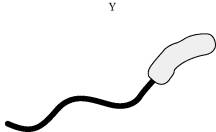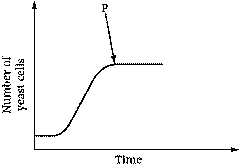

8C Quick Quiz
8Ca
1 Two different sorts of microbes are:
A plants and fungi.
B crustaceans and viruses.
C viruses and bacteria.
D viruses and pollen grains.
2 Which of these lists the organisms in the correct size order, smallest first?
A viruses, bacteria, fungi, rose bushes, elephants
B elephants, rose bushes, fungi, bacteria, viruses
C bacteria, viruses, fungi, rose bushes, elephants
D fungi, bacteria, viruses, rose bushes, elephants
3 Why do some people think that viruses are not living things?
A They cannot carry out all seven of the life processes.
B They can give people diseases.
C They do not have lungs and so cannot breathe.
D They are too small to see.
4 Look at the two pictures. What do they show?


A X is a fungus and Y is a bacterium.
B X is a pollen grain and Y is a virus.
C X is a crustacean and Y is a plant.
D X is a virus and Y is a bacterium.
8Cb
1 Which microbe is used to make bread rise?
A bacteria B yeast
C plants D sodium bicarbonate
2 What gas is needed for aerobic respiration?
A carbon dioxide
B water
C oxygen
D carbon monoxide
3 Which of these shows the correct word equation for fermentation?
A oxygen + glucose ® carbon dioxide +
water (+ energy)
B carbon dioxide + water ® oxygen +
glucose
C glucose ® carbon dioxide + ethanol
(+ energy)
D xenon + krypton ® argon + neon +
moron
4 The graph shows the growth of a population of yeast.

At point ‘P’ the population stops getting bigger. One reason for this might be that:
A the yeast cells can only grow to a certain size.
B the food for the yeast has started to run out.
C is has got dark and there is not enough light for them to grow.
D the carbon dioxide for the yeast has started to run out.
8Cc
1 When a microbe gives you a disease you are said to be:
A indebted to the microbe.
B ingested by the microbe.
C injected by the microbe.
D infected by the microbe.
2 Colds, flu, chickenpox and AIDS are all caused by:
A viruses. B fungi.
C polluted air. D animals.
3 Dimitri has a cold. He may have caught this by:
A standing in a cold place for too long.
B not eating enough fruits and vegetables.
C breathing in air containing a microbe.
D staying up too late and getting very tired.
4 A theory is:
A the results of an experiment.
B the observations made during an experiment.
C a scientific idea that can be tested.
D a scientific idea that no one believes.
8Cd
1 Bacon goes off least quickly if it is kept in a:
A fridge. B fruit bowl.
C bread box. D freezer.
2 One part of your body that tries to keep microbes out is your:
A hair. B nails. C arm. D skin.
|
3 Look at the diagram. The organ shown in the diagram can kill microbes because: A it is very hot. B it squashes them. C there is no air in it. D it contains a strong acid. |
|
4 Antibodies are made by:
A red blood cells. B white blood cells.
C bacteria. D platelets.
8Ce
1 An antibiotic is a medicine that:
A kills bacteria and viruses.
B kills only viruses.
C kills only bacteria.
D is dangerous and so is no longer used.
2 Vaccines make your body:
A produce antibodies against a disease.
B stop working to allow an operation to be done.
C cool down when you get a temperature.
D produce extra cells to mend broken bones.
3 If a person is immune to a disease, they:
A keep on getting it over and over again.
B can never get the disease.
C need to be taken special care of because the disease might kill them.
D can only get the disease two or three times during their lives.
4 A microbe that is not affected by an antibiotic is said to be:
A susceptible to the antibiotic.
B resistant to the antibiotic.
C killed by the antibiotic.
D denatured by the antibiotic.